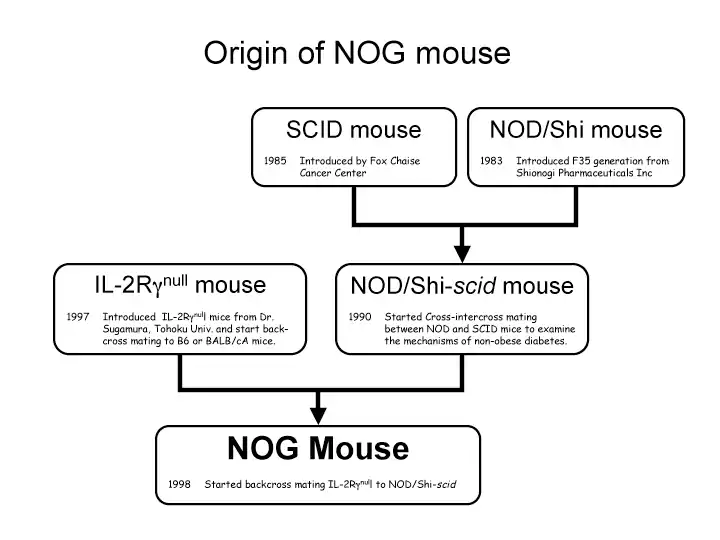NOG mouse
A NOG (NOD/Shi-scid/IL-2Rγnull) mouse is a new generation of severely immunodeficient mouse, developed by Central Institute for Experimental Animals (CIEA) in 2000. The NOG mouse accepts heterologous cells much more easily compared with any other type of immunodeficient rodent models, such as nude mouse and NOD/scid mouse. Thus, the mouse can be the best model as a highly efficient recipient of human cells to engraft, proliferate and differentiate.[1] This unique feature offers a great opportunity for enhancing therapy researches of cancer, leukemia, visceral diseases, AIDS, and other human diseases. It also provides applications for cancer, infection, regeneration, and hematology researches.
Origin
The NOG mouse was generated in CIEA in 2000 by back-cross mating of C57BL/6J-IL-2Rγnull mouse that was originally developed by Kazuo Sugamura, a professor of Tohoku University, to NOD/Shi-scid mouse that was developed in CIEA.

Characteristics
- No activity of T cell, B cell and NK cell
- Reduced complement system activity
- Dysfunction of macrophage
- Dysfunction of dendritic cell
- No leakiness: no incidence of T, B cells with aging
- No incidence of lymphoma
NOG mouse has multiple immunodeficiencies that are principally derived from three strains of mice: 1) NOD/Shi inbred strain, 2) SCID, 3) IL-2Rγnull. These include:
- Reduced innate immunity derived from a NOD inbred strain, which involves a macrophage dysfunction, and a defect of complement hemolytic activity and reduced NK activity.[2] The NOD/Shi inbred strain was first discovered by Makino et al. as autoimmune non-obese-type diabetes mice.[3][4]
- Lack of functional T and B cells that is derived from a mutation of protein kinase (Prkdc: protein kinase, DNA activated, catalytic polypeptide), which is the causative gene of the scid mutation [5][6]
- Lack of NK cells, dendritic cell dysfunctions, and other unknown deficiencies due to inactivation of the IL-2Rγ gene.[7][8][9][10]
Applications to medical researches
See also
References
- M. Ito and, et al. (2002). "NOD/SCID/γnull mouse: an excellent recipient mouse model for engraftment of human cells". Blood. 100 (9): 3175–3182. doi:10.1182/blood-2001-12-0207. PMID 12384415.
- Shultz, L. D.; Schweitzer, P. A.; Christianson, S. W.; Gott, B.; Schweitzer, I. B.; Tennent, B.; McKenna, S.; Mobraaten, L.; Rajan, T. V.; et al. (1995). "Multiple defects in innate and adaptive immunologic function in NOD/LtSz-scid mice". Journal of Immunology. 154 (1): 180–191. PMID 7995938.
- Kikutani, H.; Makino, S. (1992). "The Murine Autoimmune Diabetes Model: NOD and Related Strains". Advances in Immunology Volume 51. Advances in Immunology. Vol. 51. pp. 285–322. doi:10.1016/S0065-2776(08)60490-3. ISBN 9780120224517. PMID 1323922.
- Makino, S.; Kunimoto, K.; Muraoka, Y.; Mizushima, Y.; Katagiri, K.; Tochino, Y. (1980). "Breeding of a non-obese, diabetic strain of mice". Jikken Dobutsu. 29 (1): 1–13. doi:10.1538/expanim1978.29.1_1. PMID 6995140.
- Bosma, G. C.; Custer, R. P.; Bosma, M. J. (1983). "A severe combined immunodeficiency mutation in the mouse". Nature. 301 (5900): 527–530. Bibcode:1983Natur.301..527B. doi:10.1038/301527a0. PMID 6823332. S2CID 4267981.
- Kirchgessner, C. U.; Patil, C. K.; Evans, J. W.; Cuomo, C. A.; Fried, L. M.; Carter, T.; Oettinger, M. A.; Brown, J. M. (1995). "DNA-dependent kinase (p350) as a candidate gene for the murine SCID defect". Science. 267 (5201): 1178–1183. Bibcode:1995Sci...267.1178K. doi:10.1126/science.7855601. PMID 7855601. S2CID 29017462.
- Ikebe, M.; Miyakawa, K.; Takahashi, K.; Ohbo, K.; Nakamura, M.; Sugamura, K.; Suda, T.; Yamamura, K.; Tomita, K.; et al. (1997). "Lymphohaematopoietic abnormalities and systemic lymphoproliferative disorder in interleukin-2 receptor gamma chain-deficient mice". Int J Exp Pathol. 78 (3): 133–148. doi:10.1046/j.1365-2613.1997.230356.x. PMC 2694530. PMID 9306921.
- Ohbo, K.; Suda, T.; Hashiyama, M.; Mantani, A.; Ikebe, M.; Miyakawa, K.; Moriyama, M.; Nakamura, M.; Katsuki, M.; et al. (1996). "Modulation of hematopoiesis in mice with a truncated mutant of the interleukin-2 receptor gamma chain". Blood. 87 (3): 956–967. doi:10.1182/blood.V87.3.956.bloodjournal873956. PMID 8562967.
- Ohteki, T.; Fukao, T.; Suzue, K.; Maki, C.; Ito, M.; Nakamura, M.; Koyasu, S. (1999). "Interleukin-12 dependent interferon-g production by CD8a + lymphoid dendritic cells". J Exp Med. 189 (12): 1981–1986. doi:10.1084/jem.189.12.1981. PMC 2192968. PMID 10377194.
- Sugamura, K.; Asao, H.; Kondo, M.; Tanaka, N.; Ishii, N.; Ohbo, K.; Nakamura, M.; Takeshita, T. (1996). "The interleukin-2 receptor gamma chain: its role in the multiple cytokine receptor complexes and T cell development in XSCID". Annu Rev Immunol. 14: 179–205. doi:10.1146/annurev.immunol.14.1.179. PMID 8717512.
External links
- NOG mouse
- Base NOG Mouse http://www.taconic.com/nog
- TK-NOG http-//www.taconic.com/12907
- hGM-CSF/hIL3-NOG - http://www.taconic.com/13395
- B2m-NOG - http://www.taconic.com/13439
- CIEA Site - https://www.ciea.or.jp/en/nog_mouse.html